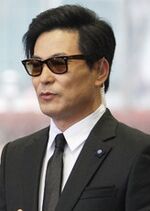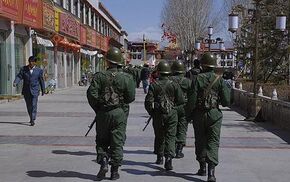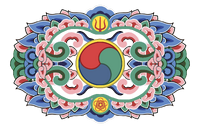| Great Kyo Revolution of 3608 | |
|---|---|

| |
| Date | 6 July 3608 to 20 March 3611 |
| Location | Dranland |
| Result | End of Dranland, creation of Kyo state of Dankuk |
| Belligerents | |
Supported By: |
Allegedly Supported By: |
| Commanders | |
The Great Kyo Revolution of 3608 was a historic Kyo cultural and political revolution in the Republic of Dranland. The revolution, led by Lee Dong-seung and his ultra-nationalist Kyo organization, brought the Republic of Dranland to an end, replacing it with the Kyo state of Dankuk. This would be the first Kyo nation since the Dranian Seung Revolution of 2964, and before that, the original kingdom that dismantled in the 1700s by Egelian colonists.
The outcome the revolution had an enormous impact on Dovani and it forever changed society and culture on the Dranian Peninsula. While the Kyo regained dominance over their ancient homeland, the other ethnic groups suffered, particular the Draddwyr, who were largely removed from the nation, either through resettlement or eradication. The Dranianos were initially targeted as well, though they were granted considerable autonomy within Ulbrach. Over time the Dranianos became more integrated with the Kyo; the same never occurred for the remaining Draddwyr in Dankuk.
Today it is widely commemorated as an official public holiday; the Day of the Sun.
Chronology of Events[]
The direct chain of events leading to the Great Kyo Revolution of 3608 is heavily debated, but all agree that the major impetus for revolution was the formation of the Kyo Revolutionary Society (KRS). Prior to the KRS there had been constantly lingering ethnic tensions, particularly between the Kyo and Draddwyr. As Kyo ethnic identity began to re-emerge as a major political and societal force in the mid-3400s and early 3500s, domestic unrest increased. Both sides were responsible for bloodshed and terror, and both sides also felt victimized. For the Kyo, this feeling of victimization, combined with a solid national political movement, led towards an ever stronger desire for a restored national identity.
The KRS originated in 3593 as an anonymous internet community that titled itself as the Revolutionary Society of the Kyo Defense Force (KDF). The group gained national attention when the Iglesia Mayor uncovered the group's online discussions in June 3594. The group remained ignored until they published a 3597 manifesto outlining the idea of "Kyobando" (쿄반도).

By 3601 the Revolutionary Committee had become more formally organized, establishing Lee Dong-seung as its leader. The organization re-branded itself as the Kyo Revolutionary Society and it transformed into a national political party. Running in the 3601 parliamentary elections, the KRS faced utter failure, other than the election of Lee Dong-seung. Failing yet again to gain major representation in 3603 snap elections, the KRS began to lay out serious plans for action against the national government, led by President Park Taeyung of the Kyo Defense Force.
Closely, yet secretly, connected to the KRS was Minister of Defense Lu Min-wei. With the aid of loyalists in the military, as well as veterans of Gonghodae, the KDF paramilitary of the Cubrero era, General Lu assisted Lee Dong-seung in overthrowing the Dranish government. Disapproving of the ultra-nationalists, King Yongchae abdicated and his son, Jongki, was crowned as the first sovereign Kyo monarch. Baek Manseok, head of the ancient Baek dynasty, sought to work with Jongki in hopes of reaching a power-sharing agreement between the Houses of Baek and Ryeo. Whilst Baek was considered useful during the revolutionary events of 3608, Jongki subsequently betrayed and exposed him by arguing that his mixed Draniano and Draddwyr heritage disqualified him from participation in government. Jongki moved to execute Baek, but Lee Dong-Seung managed to commute his sentence to life-long house arrest in the remote city of Monyeol.

Soldiers patrolling the streets of Gongmangdo following the coup.
The most radical laws, such as the one-child policy and second-class citizenship for minorities, persisted through most of Lee Dong-seung's presidency. His presidency ended with his death in 3648 but the nation remained a dictatorship, albeit a much more liberalized one. Even so, ultra-nationalism would persist through the remainder of the century, seeking to revive the early days of the revolution. The worst expression of this ideology was the 3649 crisis, which saw General Ito Ryouichi overthrow the government and murder King Jongki III, Crown Prince Jinkyun, and Duke Ryoji I.
Despite the radicalism associated with the Great Kyo Revolution of 3608 its date is one of the most important national holidays in Dankuk. It is regarded as the nation's day of independence and it is often marked by major celebrations all across the country.

|
大拜花國 Kingdom of Great Bae | |
| Geography • History • Culture • Economy • Government | ||
|---|---|---|
| History | Baekgu Dynasty • Beonyeongsalm Palace • Dranland • Dranian Zenshō Revolution • Egelian Drania • Flag of Dankuk • Great Kyo Revolution • House of Ryeo • House of Santiago • Kyobando Manifesto • Kyo-Indralan Revolutionary War • August Revolution • Dranian Civil War • DNWA • Republican Period • Baek Restoration • Timeline of the History of Dankuk | |
| Subdivisions | Provinces: Metropolitan Cities: Capital City: | |
| Politics | President of Dankuk • Chairman of the Council of Ministers • National Congress • Constitution of Dankuk Political Parties | |
| Demographics | Religion: Aurorian Patriarchal Church • Daenism • Seodongyo • Sindo • Zenshō Ethnicity: Majority: Kyo Minority: Draddwyr • Draniano | |
